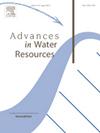基于深度学习的地下储氢代理模型
IF 4.2
2区 环境科学与生态学
Q1 WATER RESOURCES
引用次数: 0
摘要
地下储氢(UHS)是整合间歇性可再生能源的关键,它在过剩时期将多余的能量储存为氢气,在短缺时期回收。有效的UHS设计需要准确预测氢羽流迁移和储层压力演化,通常通过高保真的数值模拟来实现。尽管这些基于物理的模拟是准确的,但它们的计算成本很高,不适合快速决策。为了解决这个问题,我们使用swwin - unet开发了高效的UHS预测代理模型,swwin - unet是一种基于转换器的深度学习架构,具有U-Net结构。结果表明,swan - unet能够准确预测非均质衰竭气藏含氢饱和度和储层压力的时空演化,为传统模拟提供了一种快速、可靠的替代方法。与基于U-Net和Segmentation Transformer (SETR)的替代模型相比,swwin - unet在保持相似训练成本的同时实现了更高的压力预测精度。对于氢饱和度预测,swing - unet达到了比SETR更高的精度,与U-Net相当的精度,同时相对于U-Net减少了大约三分之二的GPU内存使用和大约75%的训练时间。这是首个将swing - unet应用于UHS替代建模的研究,证明了其作为传统物理模拟的准确有效近似的潜力。swan - unet能够在非均质地质地层中进行准确、高效的UHS预测,支持敏感性分析、不确定性量化和未来UHS项目的操作优化。本文章由计算机程序翻译,如有差异,请以英文原文为准。
Deep learning-based surrogate modeling for underground hydrogen storage
Underground hydrogen storage (UHS) is critical for integrating intermittent renewable energy sources by storing excess energy as hydrogen during surplus periods and retrieving it during shortages. Effective UHS design requires accurate prediction of hydrogen plume migration and reservoir pressure evolution, typically achieved by high-fidelity numerical simulations. Although these physics-based simulations are accurate, they are computationally expensive and unsuitable for rapid decision-making. To address this, we develop efficient surrogate models for UHS prediction using Swin-Unet, a transformer-based deep learning architecture with a U-Net structure. Our results show that Swin-Unet accurately predicts the spatiotemporal evolution of hydrogen saturation and reservoir pressure in heterogeneous depleted gas reservoirs, offering a fast and reliable alternative to traditional simulations. Compared to surrogate models based on U-Net and Segmentation Transformer (SETR), Swin-Unet achieves higher pressure prediction accuracy while maintaining similar training costs. For hydrogen saturation prediction, Swin-Unet achieves higher accuracy than SETR and comparable accuracy to U-Net, while reducing GPU memory usage by about two-thirds and training time by approximately 75% relative to U-Net. This is the first study to apply Swin-Unet to surrogate modeling of UHS, demonstrating its potential as an accurate and efficient approximation for traditional physics-based simulations. Swin-Unet enables accurate and efficient UHS prediction in heterogenous geological formations, supporting sensitivity analysis, uncertainty quantification, and operational optimization for future UHS projects.
求助全文
通过发布文献求助,成功后即可免费获取论文全文。
去求助
来源期刊

Advances in Water Resources
环境科学-水资源
CiteScore
9.40
自引率
6.40%
发文量
171
审稿时长
36 days
期刊介绍:
Advances in Water Resources provides a forum for the presentation of fundamental scientific advances in the understanding of water resources systems. The scope of Advances in Water Resources includes any combination of theoretical, computational, and experimental approaches used to advance fundamental understanding of surface or subsurface water resources systems or the interaction of these systems with the atmosphere, geosphere, biosphere, and human societies. Manuscripts involving case studies that do not attempt to reach broader conclusions, research on engineering design, applied hydraulics, or water quality and treatment, as well as applications of existing knowledge that do not advance fundamental understanding of hydrological processes, are not appropriate for Advances in Water Resources.
Examples of appropriate topical areas that will be considered include the following:
• Surface and subsurface hydrology
• Hydrometeorology
• Environmental fluid dynamics
• Ecohydrology and ecohydrodynamics
• Multiphase transport phenomena in porous media
• Fluid flow and species transport and reaction processes
 求助内容:
求助内容: 应助结果提醒方式:
应助结果提醒方式:


